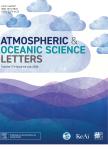Model Evaluation and Projection on the Linkage between Hadley Circulation and Atmospheric Background Related to the Tropical Cyclone Frequency over the Western North Pacific
Model Evaluation and Projection on the Linkage between Hadley Circulation and Atmospheric Background Related to the Tropical Cyclone Frequency over the Western North Pacific作者机构:National Climate Center Beijing 100081 China Nansen-Zhu International Research Center Institute of Atmospheric Physics Chinese Academy of Sciences Beijing 100029 China
出 版 物:《Atmospheric and Oceanic Science Letters》 (大气和海洋科学快报(英文版))
年 卷 期:2012年第5卷第6期
页 面:473-477页
学科分类:07[理学] 070601[理学-气象学] 0706[理学-大气科学]
基 金:supported by the National Basic Research Program of China(2009CB421407) the National Natural Science Foundation of China(41275078) the Special Fund for Public Welfare Industry (Meteorology) (GYHY200906018)
主 题:Hadley circulation atmospheric circulation tropical cyclone assessment projection
摘 要:The performance of climate models in simulating the linkage of the spring Hadley circulation (HC) to the vertical zonal wind shear and atmospheric divergence in the lower and upper troposphere, which are related to the tropical cyclone frequency over the western North Pacific (WNPTCF) during June-September (JJAS), is evaluated on the basis of the 20th century climate simulations (20C3M). It is found that four models can simulta-neously reproduce the pattern revealed in the observation, with the spring HC in the Northern Hemisphere being positively correlated to the vertical zonal wind shear in the major tropical cyclone (TC) genesis region and negatively (positively) correlated to the atmospheric diver- gence in the upper (lower) troposphere over the western North Pacific (WNP) in the following JJAS. These four models are further used to project their relationship in the late 21st century under the A1B scenario. The results show that the association of spring HC with the vertical zonal wind shear and the upper-and lower-tropospheric divergence over the WNP will weaken in the late 21st century, thereby resulting in a weak relationship between the spring HC and the JJAS WNPTCF.



